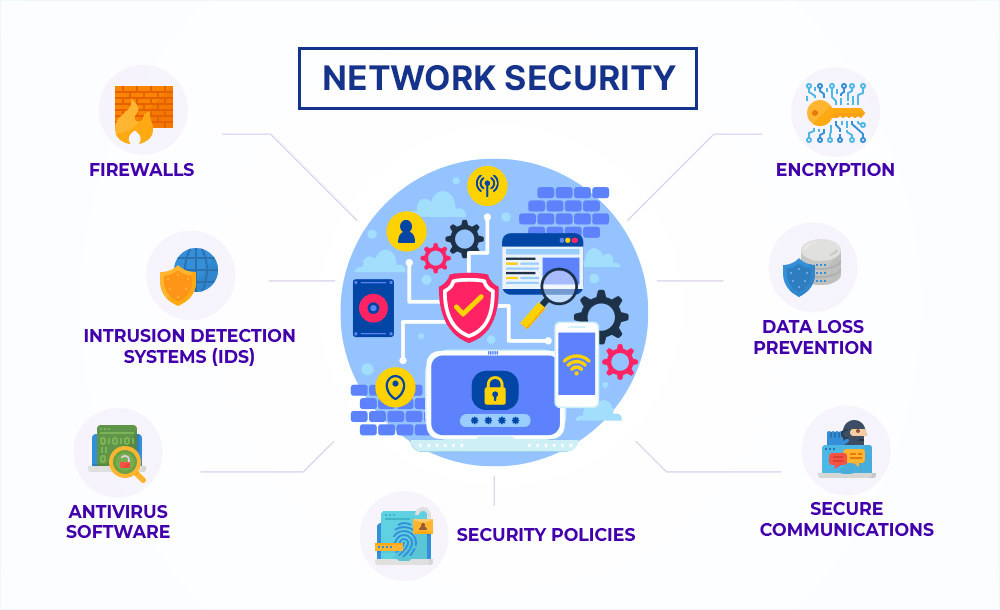
- Introduction to Cybersecurity vs. Network Security
- Key Differences Between Cybersecurity and Network Security
- Understanding Cybersecurity
- Cybersecurity Threats vs. Network Security Threats
- Understanding Network Security
- How Cybersecurity and Network Security Work Together
- Why Both Cybersecurity and Network Security Are Essential
- The Future of Cybersecurity and Network Security
- Conclusion
Cybersecurity and network security are closely related but distinct fields. Cybersecurity is a broad domain focused on protecting digital assets, data, and systems from cyber threats, including malware, phishing, and hacking. It encompasses various security measures like encryption, endpoint protection, and identity management. Network security, a subset of cybersecurity, specifically deals with securing network infrastructure, preventing unauthorized access, and ensuring data integrity through firewalls, intrusion detection systems (IDS), and VPNs. Cyber Security Training Courses are essential in helping individuals understand these technologies and implement effective security measures to protect against evolving cyber threats. While cybersecurity covers all aspects of digital protection, network security concentrates on safeguarding communication channels and preventing breaches at the network level. Both are essential for a robust security strategy.
Interested in Obtaining Your Cyber Security Certificate? View The Cyber Security Online Training Offered By ACTE Right Now!
Introduction to Cybersecurity vs. Network Security
Cybersecurity and network security are two key elements in protecting digital infrastructure. As cyber threats become more complex, understanding the distinctions and interconnections between these two fields is crucial for organizations. Cybersecurity encompasses a broad approach to protecting all forms of digital assets, while network security specifically focuses on the security of network infrastructure. A key element of both is Cryptography in Cybersecurity, which plays a vital role in securing communications and data transmission across networks. Both are essential for preventing attacks, data breaches, and other malicious activities in today’s interconnected world Cybersecurity includes areas like data protection, application security, and user authentication, while network security involves firewalls, intrusion detection systems, and secure network protocols. Together, they form a comprehensive defense against evolving cyber threats.
Key Differences Between Cybersecurity and Network Security
- Focus and Objectives: Cybersecurity is a broad field that aims to protect digital systems, applications, and data from cyber threats like malware, hacking, and phishing. Network security, on the other hand, specifically focuses on safeguarding network infrastructure, preventing unauthorized access, and ensuring secure communication between connected devices.
- Scope of Protection: Cybersecurity covers the entire digital ecosystem, including cloud platforms, endpoints, databases, and applications. It protects data in storage and transit across multiple platforms. Network security is more limited in scope, concentrating on securing data as it moves through networks and defending against attacks that exploit network vulnerabilities.
- Tools and Techniques: Cybersecurity employs tools such as antivirus software, encryption, identity management, and endpoint security to protect against various cyber threats. One critical component in encryption is the RSA Algorithm, which is widely used for secure data transmission and digital signatures.
- Threat Mitigation: Cybersecurity addresses a wide range of threats, including ransomware, social engineering, and insider threats. Network security focuses on network-based threats like denial-of-service (DoS) attacks, man-in-the-middle (MITM) attacks, and unauthorized access attempts.
- Application and Implementation: Cybersecurity strategies are applied across entire IT environments, including software, databases, and user devices. Network security measures are implemented at the network level, ensuring safe data transfer and blocking malicious traffic. Both cybersecurity and network security are essential for a comprehensive security strategy, working together to protect digital assets from evolving cyber threats.
Understanding Cybersecurity
Cybersecurity refers to the practice of protecting systems, networks, and programs from digital attacks, damage, or unauthorized access. It involves safeguarding various aspects of the digital ecosystem, including hardware, software, and data. Cybersecurity addresses a wide range of threats, from viruses and malware to more advanced threats like phishing, ransomware, and insider attacks. It focuses on securing sensitive data and ensuring the integrity, confidentiality, and availability of critical information across the entire digital infrastructure, not just the network layer. Cybersecurity incorporates various security measures such as encryption, multi-factor authentication, intrusion detection systems, and endpoint protection. It plays a crucial role in preventing financial losses, reputational damage, and legal consequences resulting from cyberattacks. Organizations implement cybersecurity strategies through security policies, regular security audits, and employee awareness training. As cyber threats evolve, proactive defense mechanisms, including artificial intelligence-based threat detection and zero-trust security models, become increasingly important. Cybersecurity professionals continuously monitor networks, identify vulnerabilities, and respond to incidents to minimize risks. Ultimately, cybersecurity is essential for governments, businesses, and individuals to safeguard critical digital assets and maintain trust in technology.
Are You Interested in Learning More About Cybersecurity? Sign Up For Our Cyber Security Online Training Today!
Cybersecurity Threats vs. Network Security Threats
- Cybersecurity Threats: Cybersecurity and network security are closely related but distinct fields. Cybersecurity is a broad domain focused on protecting digital assets, data, and systems from cyber threats, including malware, phishing, and hacking. It encompasses various security measures like encryption, endpoint protection, and identity management. These threats include ransomware, data breaches, social engineering, and insider threats, affecting not just networks but also applications, databases, and user access. Network security, a subset of Cyber Security Training Courses, specifically deals with securing network infrastructure, preventing unauthorized access, and ensuring data integrity through firewalls, intrusion detection systems (IDS), and VPNs. Both are essential for a robust security strategy.
- Network Security Threats: Cybersecurity and network security are closely related but distinct fields. Cybersecurity is a broad domain focused on protecting digital assets, data, and systems from cyber threats, including malware, phishing, and hacking. It encompasses various security measures like encryption, endpoint protection, and identity management. Network security, a subset of cybersecurity, specifically deals with securing network infrastructure, preventing unauthorized access, and ensuring data integrity through firewalls, intrusion detection systems (IDS), and VPNs. These threats are more specific to network infrastructure and include Denial-of-Service (DoS), Distributed Denial-of-Service (DDoS), man-in-the-middle (MITM) attacks, eavesdropping, and unauthorized access, exploiting vulnerabilities in protocols or configurations.

Understanding Network Security
cybersecurity and network security are critical components of modern digital protection. Cybersecurity is a broad field that safeguards systems, networks, and data from cyber threats such as malware, ransomware, phishing, and hacking. It includes disciplines like encryption, endpoint security, identity management, and incident response. Network security, on the other hand, is a subset of cybersecurity that focuses specifically on protecting the integrity, confidentiality, and availability of data and resources as they are transmitted across or accessed through network systems. A key element in safeguarding against unauthorized access is Human vs. Bot Detection CAPTCHA Types, which help prevent automated attacks by distinguishing between legitimate users and malicious bots. It involves measures such as firewalls, intrusion detection and prevention systems (IDPS), virtual private networks (VPNs), and encryption to protect network traffic from unauthorized access and threats. Network security aims to defend against attacks on the network infrastructure, including data interception, DDoS attacks, and unauthorized access to connected devices. Both cybersecurity and network security are essential for a strong security framework. While cybersecurity protects a broader range of digital assets, network security ensures secure communication and data transfer, making them complementary in mitigating cyber risks and securing digital environments.
Looking to Master Cybersecurity? Discover the Cyber Security Expert Masters Program Training Course Available at ACTE Now!
How Cybersecurity and Network Security Work Together
- Cybersecurity and network security work hand in hand to provide comprehensive protection.
- While network security focuses on securing communication pathways and network infrastructure, cybersecurity ensures the safety of all digital assets, including those accessed via the network.
- For example, network security protects data in transit from eavesdropping or interception, while cybersecurity ensures that the data remains secure once it reaches the endpoint device.
- Network security involves firewalls, intrusion detection systems (IDS), and VPNs to safeguard traffic, whereas cybersecurity incorporates encryption, multi-factor authentication, and endpoint security to prevent breaches.
- Together, they form a defense-in-depth strategy, minimizing vulnerabilities and preventing cyberattacks from multiple angles, including defending against common threats like Phishing Attacks, which aim to trick users into revealing sensitive information.
- With the rise of cloud computing, IoT, and remote work, cybersecurity threats have become more sophisticated, requiring an integrated approach.
- Organizations must implement best practices like regular security audits, employee training, and proactive monitoring to enhance both network and cybersecurity.
- A well-rounded security framework ensures resilience against evolving cyber threats, safeguarding sensitive information, critical systems, and overall business continuity in an increasingly digital world.

Why Both Cybersecurity and Network Security Are Essential
Both cybersecurity and network security are critical because they address different layers of defense within an organization’s IT infrastructure. Cybersecurity is essential to protect all aspects of a company’s digital presence, including data, applications, and endpoints. Network security, however, is necessary to ensure that the communication channels through which data flows are secure. Without effective network security, hackers can exploit weaknesses in the network to gain unauthorized access to a system, making the broader cybersecurity efforts ineffective. Together, they form a holistic security strategy that protects an organization’s digital environment from a wide range of cyber threats.
The Future of Cybersecurity and Network Security
- As cyber threats evolve, the future of cybersecurity and network security will rely heavily on emerging technologies like artificial intelligence (AI), machine learning, and quantum computing.
- AI and machine learning will play an increasingly important role in detecting and responding to threats faster and more accurately by analyzing patterns and identifying anomalies in network traffic.
- Network security will also see the rise of more advanced encryption techniques, such as the Playfair Cipher, and better network segmentation to minimize the impact of breaches.
- Additionally, as more devices are connected through the Internet of Things (IoT), both cybersecurity and network security will need to adapt to new challenges presented by these devices.
Preparing for Cyber Security Job Interviews? Have a Look at Our Blog on Cyber Security Interview Questions and Answers To Ace Your Interview!
Conclusion
While cybersecurity and network security are closely related, they are distinct fields with unique focuses. Cybersecurity offers a broad approach to protecting digital assets across systems and data, while network security zeroes in on securing the network infrastructure that connects all devices and systems. Both are necessary for an organization to defend itself against modern cyber threats. A comprehensive security strategy requires the integration of both cybersecurity and network security to create a robust defense mechanism that addresses vulnerabilities at multiple levels, ensuring overall protection against evolving cyber risks. Cyber Security Training Courses are also crucial in equipping employees with the knowledge to recognize and respond to potential threats, enhancing the overall security posture. Cybersecurity includes areas like endpoint protection, encryption, access control, and threat intelligence to safeguard sensitive data and prevent cyberattacks. It focuses on mitigating risks from malware, ransomware, phishing, and insider threats. Network security, on the other hand, ensures the security of data transmission and communication channels by implementing firewalls, intrusion detection systems (IDS), VPNs, and access control mechanisms. A strong cybersecurity framework incorporates both network security and broader IT security measures to create a layered defense, helping organizations minimize risks, prevent unauthorized access, and maintain the confidentiality, integrity, and availability of critical data and resources.





